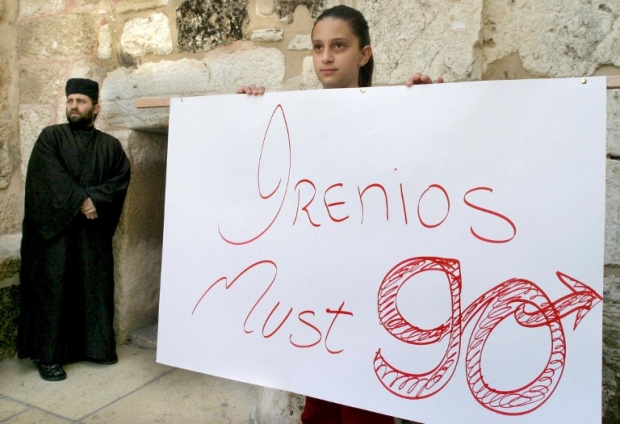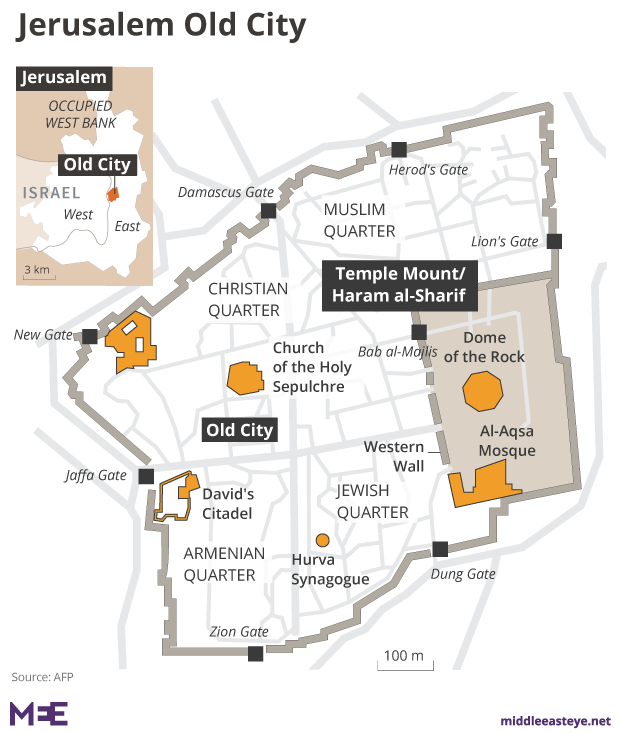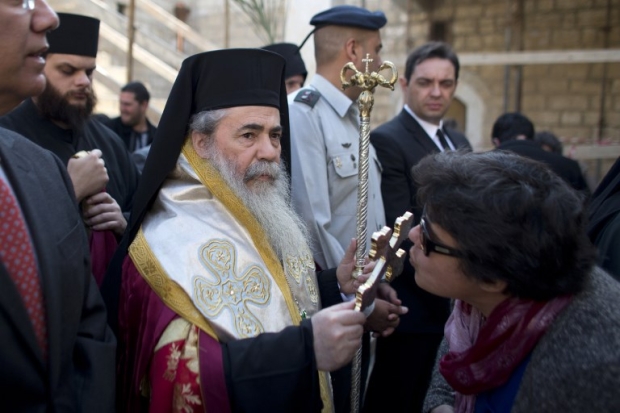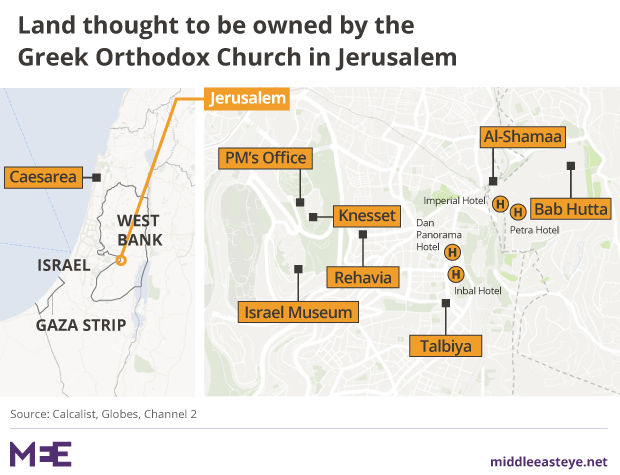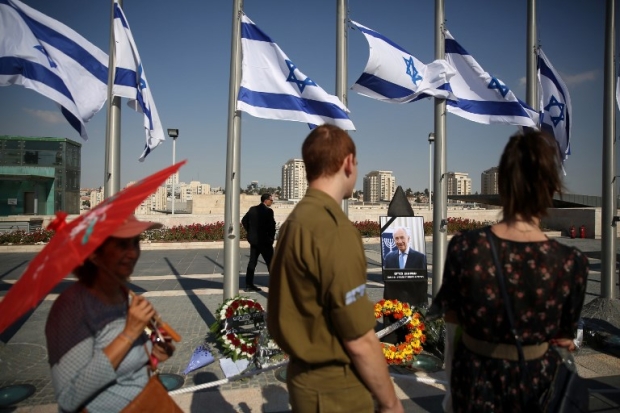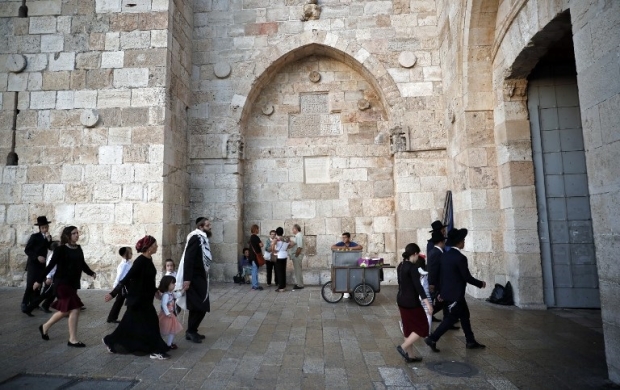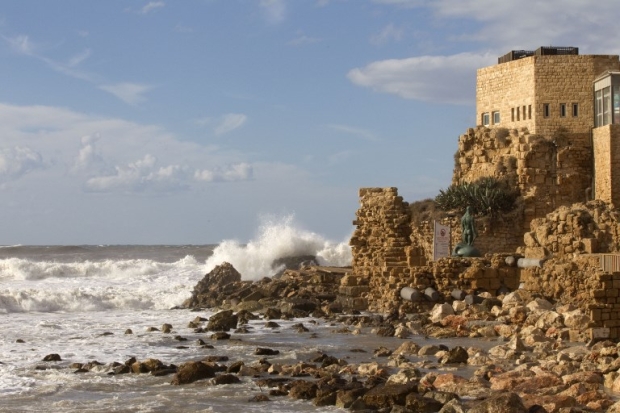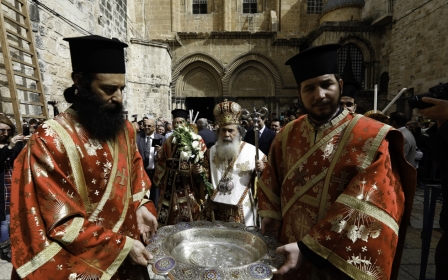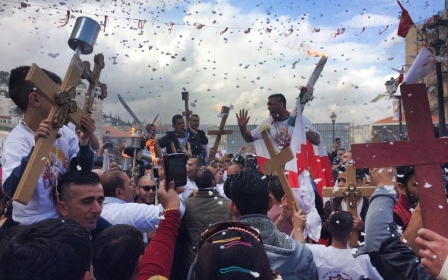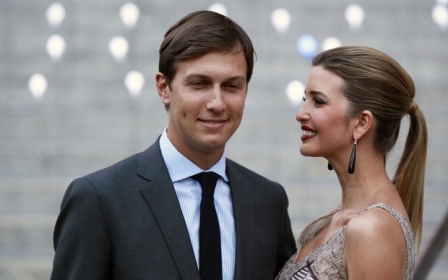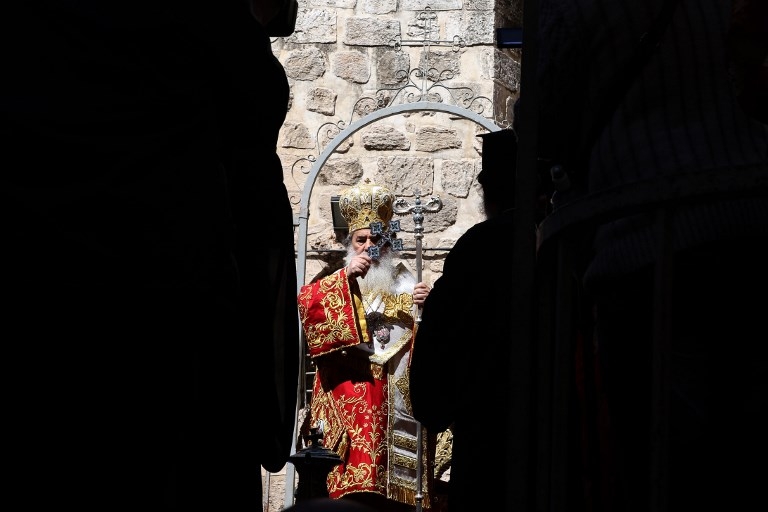
The most disputed land on earth: How Greek Orthodox church sold off Palestinian plots
It’s been a hot summer for the Greek Orthodox Church in Jerusalem, as Palestinian calls for the removal of Patriarch Theophilos III and other church leaders accused of selling property to Israeli settlers have escalated.
The demands started in late June when the Israeli financial news site Calcalist revealed that the Greek Orthodox Church had secretly sold more than 100 acres of prime West Jerusalem land to Israeli institutions and companies for a mere $10m.
A month later, an Israeli court upheld a 2004 property deal on three properties in the Old City of Jerusalem between the church and a settler group which aims to create a Jewish majority there. And that was followed by a report revealing that the church sold its land in the coastal town of Caesarea, a Palestinian town whose inhabitants have been evicted.
Over the years, crises involving its holdings have purportedly involved everything from secret tape recordings and offshore bank accounts to alleged bribery and a former patriarch, Irineos, who has been confined inside the church's Jerusalem compound since 2005.
What’s different now are the strength of the calls from the Palestinian Orthodox community, which has been locked in a battle dating back more than 500 years when the Greeks took control of the church – but never gave it back.
Triggered by the summer revelations, Palestinian Orthodox protesters have demanded not only to manage the church’s properties and for existing suspicious deals to be annulled, but also for the appointment of a Palestinian patriarch and church representative. It would signal end to what many see as the Greek colonisation of the Palestinian Orthodox church.“All the orthodox churches in the world are national ones,” Alif Sabbagh, a member of the Central Orthodox Council in Israel, told MEE in August.
“The Bulgarian church, for example, has Bulgarian leadership, the Greek one in Greece has Greek leadership, the same in Russia, Romania... Except us. Our church has Greek leadership.”
How did Greek church come to dominate?
The story of how Greek influence over the church became so powerful stretches back over centuries.
1. Origins: Palestinian Orthodox Christians are considered to be the indigenous inhabitants who have lived on the land for more than 2000 years. They constitute 99 percent of the current Orthodox community, whose origins are the Arab tribes of Ghassanids, Taghlibis and Manadhira.
Historians point out that the beginning of the Orthodox church in Jerusalem dates back to the time of Jacob the prophet, the son of Joseph the carpenter who died in 62 AD. In 637, according to historic accounts, Sophronius, the Arab patriarch of Damascus, gave the keys of Jerusalem to the Islamic Caliph Omar Ibn al-Khattab.
2. Invasion: The Crusaders occupied the area in 1099, as Orthodox Christians and Muslims alike suffered from injustice and tyranny.
3. Liberation: Nearly 100 years later, Orthodox Christians participated in Salah al-Din al-Ayyubi’s army as it liberated Jerusalem. Palestinians still remember the heroism of the Arab Orthodox community leader, Issa al-Awam, who played a major role in the victories of Salah al-Din in Acre. After defeating the Crusaders, the Arab clergy regained control of the Orthodox Church.
4. Enter the Greeks: But in 1534, the Greek Patriarch Germanus became the Patriarchate. Until then, the Patriarchate – its patriarch, archbishop, bishops and monks - had been comprised of Arabs. Arabic was the official language of the church.
Once Germanus took the reins, he turned the Jerusalem church Greek from head to toe. Over 45 years, he succeeded in removing the Arab clergy from influential positions, replacing them with Greek clerics.
Importantly, the fraternity of the Holy Sepulchre, the church's leadership body and the only entity capable of appointing the next patriarch, was filled with Greeks. It meant that Germanus could ensure, before his death, that his replacement would also be Greek so as to maintain control over the church.
5. The foundations: The Greek Patriarch Dositheos, who was elected in 1669, put a law in place which allowed only Greek clergy to become members of the brotherhood of the Holy Sepulchre, the church’s leadership body. They became completely distanced from the Arab Orthodox community, a trend that continued as the Ottomans, the British and finally, the Israeli authorities adopted the law which is still in place now.
From the perspective of many Palestinian Christians, for 500 years the church in Jerusalem has considered itself the protector solely of Greek interests. It has paid little attention to the citizens and members of their community, they say, whose affairs are managed by strangers who don’t speak Arabic and know nothing about the nature the country or its people.
6. The Palestinian pushback: More than 100 years ago, Orthodox Palestinians tried to change the status quo and manage their property, religious endowments and affairs. They organised conferences, and protests, including a widespread demonstration in 1909 during which four protesters were killed by Ottoman security forces.
These attempts were not successful due to the international interests of the British Mandate, the Greek church, those countries involved after the fall of the Ottoman Empire - despite Ottoman promises to give the church back to Arab control - and, eventually Israel. The situation remains unchanged.
The deals we know about
The Greek Orthodox Church in Jerusalem has long refused to disclose the details of its dealings. It claims that its land endowments are private Greek property and that Palestinian members of the church, who make up 99 percent of the local Orthodox community, have no right to the property, despite the fact that they are the ones who endowed most of the land to the church in order to serve their community and their people.
Last August, an unprecedented ruling from the Israeli Supreme Court agreed with the church that the affairs of its supreme council could be kept secret. The ruling shows the extent to which the Israeli courts are keen on keeping the church and its secrets exposed.
For the benefit of the residents of Jerusalem and the State of Israel, there is an urgent need to keep the deal and its details confidential
- Greek Orthodox Patriarch Theophilos III in a leaked letter published in June
When they do uncover details about the church’s deals, Palestinians usually learn about them through leaks reported in Israeli media which covers them because any sale of the church's widespread portfolio may have a significant impact on the economy.
But these stories typically come out after agreements are signed and deeds are registered, making the deals very difficult to stop – which is exactly why it would appear that the parties involved are keen to keep them so quiet.
In a letter published by Calcalist in late June, demanding the acceleration of land sales for a neighbourhood in West Jerusalem, Theophilos III tells local authorities that secrecy is needed because "some parties in the country and abroad are hostile, as they tried often and again to prevent such deals.
“For the benefit of the residents of Jerusalem and the State of Israel, there is an urgent need to keep the deal and its details confidential,” he was quoted as writing.
While the church refuses to disclose the extent of its property portfolio, there are reliable news sources and reports which suggest that it comprises more than 20,000 acres, including buildings, churches, shrines, monasteries, cemeteries and agricultural land.
Many of these properties are thought to be concentrated in city centres such as Jerusalem, Jaffa, Bethlehem, Haifa, Beit Sahour, Nazareth, Acre, Jericho, Safed, Tiberias, Lod, Ramlah, Beersheba and other places of significant economic and strategic value. Others have great religious and historic value. MEE asked the church to confirm that it held properties in these cities, but again did not receive a response.Here is an outline of those agreements which have leaked recently:
1. The Al-Shamaa affair
In 1927, according to a report in Al Akbar al-Balad, the church secretly sold 9.3 acres of land in Jerusalem, outside Jaffa Gate. It was sold to an Egyptian Jewish investor, Eli Shamaa, for 38,000 Egyptian pounds. It was to be paid in instalments and mortgaged to the church until full payment.
In 1970, after the investor breached the agreement, the church filed a lawsuit in an Israeli court. The church demanded either that the land be re-appropriated, or that Shamaa compensate the church for more than $14m. Israel, however, claimed that the land was absentee property.
Although the court eventually found in favour of the church, it surprisingly and without giving reasons, retracted its claim and relinquished the land.
2. The Rahavia deal
In 1936, the church leased a vast amount of territory in Rahavia, an area in West Jerusalem, to the Jewish National Fund for 99 years. Zionist gangs considered the deal to be a major victory in their efforts to control Jerusalem.
Between 1950 and 1952, the church signed three additional agreements, under which tens of acres of land in Rahavia, Talbieh and other areas of West Jerusalem were transferred to the Jewish National Fund.
More than 1,500 housing units were built on these lands. They include the Knesset, the prime minister's office, the Israel Museum, and luxury hotels such as the Dan Panorama and Inbal. Property values in these areas are the highest in Israel, with the average price of a house exceeding $2m.
The Israeli website Calcalist has published a news story stating that in August 2016 the Greek Patriarchate sold the ownership of its land in the mentioned areas to a foreign company, instead of getting it back after 99 years, for just over $10m. This news was leaked after the Greek Patriarch sent a letter to the Jerusalem municipality demanding that it accelerates the completion of the secret deal, and created shockwaves amid economic and media circles.
3. The Old City sale
In 2004, the church, then led by Patriarch Irineos, sold leases on three strategically located properties in Jerusalem’s Old City to Ateret Cohanim, a settler group that aims to create a Jewish majority.
Irineos has been confined in the church's compound in the Old City since 2005. A Palestinian Muslim man brings him food each day which is hoisted up to his window in a plastic bag
The properties include the Petra Hotel in Omar Bin Al Khattab Square between Jaffa Gate and Al-Arabi neighbourhood, leased for half a million dollars; Imperial Hotel, along with the shops and bazaars in contains, all located in Jaffa Gate for $1.2m; and a piece of land that includes a building known as Bait Al-Muadamiya, located near Bab Hutta in Old Jerusalem, which was leased for $55,000.
The revelation of these deals in the Israeli press in 2005 led to strong campaigns against Irineos, who was dismissed and replaced with Theophilos III after he pledged to the Jordanian and Palestinian authorities to cancel the deals. The church claims that Irineos's representative signed the agreements, worth far less than the properties were actually valued, in exchange for a $1m bribe and escape from the country.
This July, Israel’s Central Court rejected the church’s claim, instead siding with Ateret Cohanim and recognising the three deals. In an advert in Al-Quds newspaper, Theophilos pledged to appeal the decision while Palestinian Christians say they will fight the sale and occupy the sites if necessary.
4. The Caesarea agreement
Also in July, Israeli Channel 2 revealed that the church signed an agreement to sell its land in the town of Caesarea in August 2015. Caesarea is a Palestinian town whose inhabitants have been evicted and on whose ruins Israel has built a city that bears the same name.
MEE asked the church to confirm the reported accounts about these various properties but, again, did not receive a response.
What we can do
According to the Palestinian Orthodox community, the properties managed by the Greek Patriarchate belong to the Orthodox church and are intended to serve the Orthodox community. They shouldn’t be sold, especially not to settlers like Ateret Cohanim, which Palestinian Christians consider to be an act of betrayal. Instead, they should be considered part of the national heritage.
The church, however, believes that these properties belong to the Greeks. It sees no problem in selling or leasing them even to settler organisations or even in areas that Palestinians cherish like the Old City of Jerusalem.
That’s why the first step to resolving the conflicts over these sales should be to clarify what the objectives of the endowments are and what party they are meant to serve. With the revenue from these sales, schools, colleges, hospitals and other facilities beneficial to all Palestinians could be built.
Further more, preventing the "judaisation" of these endowments is a national task. All Palestinian citizens, regardless of their religion, should assume their responsibility and do what they can do to push back against the deals between the church and Zionist institutions.
They should also support the movement to bring Arabs back into the church's leadership so that Palestinian Orthodox leaders can assume responsibility for their religious and administrative matters, 500 years later.
- Jihad Abu Raya is a Palestinian lawyer and activist based in northern Israel. He is a founder of the Falestaniyat movement.
The views expressed in this article belong to the author and do not necessarily reflect the editorial policy of Middle East Eye.
Photo: Greek Orthodox Patriarch of Jerusalem Theophilos III leads the Washing of the Feet ceremony in front of the Church of the Holy Sepulchre in Jerusalem's Old City on 28 April 2016 as part of the Orthodox Easter celebrations. (AFP)
This article is available in French on Middle East Eye French edition.
New MEE newsletter: Jerusalem Dispatch
Sign up to get the latest insights and analysis on Israel-Palestine, alongside Turkey Unpacked and other MEE newsletters
Middle East Eye delivers independent and unrivalled coverage and analysis of the Middle East, North Africa and beyond. To learn more about republishing this content and the associated fees, please fill out this form. More about MEE can be found here.


